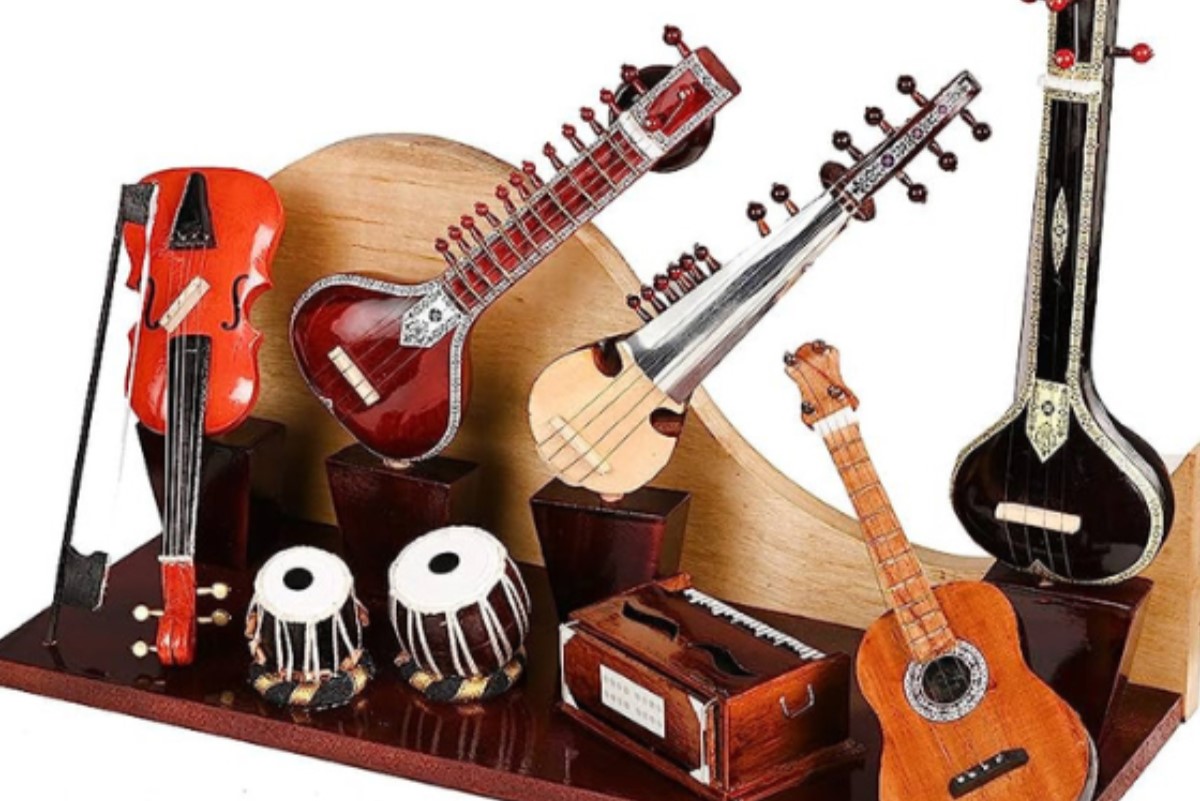
Musical instruments have been an integral part of human culture for centuries, enriching our lives with their captivating melodies and rhythms. From the majestic grandeur of the piano to the soul-stirring resonance of the violin, each instrument holds a unique charm and history. In this article, we'll delve into the fascinating world of musical instruments, uncovering intriguing facts that shed light on their evolution, significance, and enduring appeal. Whether you're a music enthusiast, a budding musician, or simply curious about the art of sound, these insights will deepen your appreciation for the diverse array of instruments that grace the global stage. So, let's embark on a melodic journey through the realms of music and discover the enchanting stories behind some of the most beloved and iconic instruments known to humanity.
Key Takeaways:
- From the ancient flute to the modern electric guitar, musical instruments have shaped the evolution of music, inspiring creativity and uniting people through the universal language of music.
- Musical instruments, like the violin and drum, have diverse origins and unique sounds, contributing to the vibrant tapestry of musical expression across cultures and centuries.
The Oldest Known Musical Instrument is a Flute
Dating back to around 43,000 years ago, a flute made from a bear bone was discovered in a cave in Germany. This ancient artifact provides evidence of early humans' musical expression and creativity.
The Piano Was Invented in Italy
Bartolomeo Cristofori, an Italian instrument maker, is credited with inventing the piano around the year The piano has since become one of the most popular and versatile musical instruments in the world.
The Electric Guitar Revolutionized Music
The invention of the electric guitar in the 1930s transformed the music industry, leading to the development of various music genres such as rock and roll, blues, and jazz. Its amplified sound and versatility have made it an iconic instrument in modern music.
The Violin Has Four Strings
The violin, a prominent instrument in classical music, is known for its four strings: G, D, A, and E. Its expressive sound and versatility have made it a staple in orchestras and solo performances.
The Saxophone Was Invented by Adolphe Sax
Belgian instrument maker Adolphe Sax created the saxophone in the 1840s. This versatile instrument is widely used in jazz, classical, and military band music, adding a unique and expressive quality to musical compositions.
The Didgeridoo is a Traditional Australian Instrument
Originating from Indigenous Australian cultures, the didgeridoo is a wind instrument known for its mesmerizing drone sound. It holds significant cultural and spiritual importance in Aboriginal traditions.
The Accordion is a Bellows-Driven Instrument
The accordion, with its distinctive sound, is operated by expanding and compressing bellows while pressing buttons or keys to produce different notes. It is a popular instrument in folk music around the world.
The Drum is One of the Oldest Musical Instruments
Dating back to ancient times, drums have been used in various cultures for communication, rituals, and music. Their rhythmic beats form the foundation of many music styles across the globe.
The Cello is Part of the Violin Family
As a member of the violin family, the cello, also known as the violoncello, is a string instrument with a rich and deep sound. It is widely used in classical music and has a prominent role in orchestras.
The Flute is a Woodwind Instrument
The flute, often made of metal or wood, is classified as a woodwind instrument due to the method of producing sound through the vibration of air within a tube. It is a versatile instrument found in various musical genres.
The Trumpet is a Brass Instrument
Known for its bright and powerful sound, the trumpet is a brass instrument with a long history dating back to ancient civilizations. It plays a vital role in orchestras, jazz bands, and various musical ensembles.
The Harp is One of the Oldest String Instruments
With its elegant and ethereal sound, the harp has a history dating back thousands of years. It is often associated with angelic and celestial imagery and is a key instrument in classical, folk, and contemporary music.
The Ukulele Originated in Hawaii
The ukulele, a small four-stringed instrument, originated in the 19th century in Hawaii. Its cheerful and bright sound has made it a popular choice for musicians and has been featured in a wide range of musical genres.
The Accordion Has Many Variations
The accordion comes in various forms, including the piano accordion, button accordion, and chromatic accordion. Each variation offers unique playing styles and sound characteristics, contributing to its versatility in music.
The Xylophone is a Percussion Instrument
Consisting of wooden bars struck by mallets, the xylophone produces a bright and resonant sound. It is commonly used in orchestral music, jazz, and as a teaching instrument for music education.
The Bass Guitar Provides Low-End Rhythmic Foundation
As a crucial part of the rhythm section in many music genres, the bass guitar delivers deep, low-frequency notes that provide a solid foundation for the overall musical composition.
The French Horn is a Key Orchestral Instrument
With its mellow and rich tone, the French horn plays a vital role in orchestras and brass ensembles, contributing to the harmonic and melodic depth of classical compositions.
The Oboe is a Double-Reed Instrument
Known for its distinctive and expressive sound, the oboe features a double reed that vibrates to produce its unique timbre. It is a prominent instrument in classical music and has a significant role in orchestral settings.
The Bagpipes are an Iconic Scottish Instrument
The bagpipes, with their distinctive drone sound, are deeply rooted in Scottish culture and are often associated with traditional Highland music and ceremonies. They hold a symbolic and historical significance in Scottish heritage.
The world of musical instruments is rich and diverse, spanning across cultures and centuries. From the ancient origins of the flute to the modern-day innovations of electric guitars, each instrument contributes to the vibrant tapestry of musical expression. Whether it's the soul-stirring melodies of a violin or the rhythmic pulse of a drum, these instruments have shaped the evolution of music and continue to inspire musicians and audiences worldwide. Embracing the beauty and diversity of musical instruments allows us to delve into the endless possibilities of creativity and artistic expression, transcending language barriers and uniting people through the universal language of music.
Conclusion
In conclusion, musical instruments are not only tools for creating beautiful melodies but also windows into diverse cultures and histories. From the ancient origins of the flute to the modern innovations in electronic instruments, the evolution of musical tools mirrors the evolution of human creativity and expression. Understanding the unique characteristics and roles of different instruments adds depth to our appreciation of music, enriching our experiences as both listeners and performers. Whether it's the resonant strum of a guitar, the rhythmic beat of a drum, or the soaring melody of a violin, each instrument contributes its own distinct voice to the symphony of human artistic expression.
FAQs
What are the different categories of musical instruments?
Musical instruments are typically categorized into four main groups: strings, woodwinds, brass, and percussion. Each category encompasses a wide range of instruments, from the delicate sound of a violin in the strings family to the powerful resonance of a tuba in the brass family.
How do musical instruments vary across different cultures?
Musical instruments vary greatly across cultures, reflecting the unique traditions, beliefs, and lifestyles of different societies. For example, the sitar holds a special place in Indian classical music, while the djembe drum is integral to West African musical traditions. These instruments not only produce distinct sounds but also carry deep cultural significance, enriching the global tapestry of musical expression.
What is the significance of musical instruments in human history?
Musical instruments have played a pivotal role in human history, serving as tools for communication, storytelling, and cultural preservation. They have accompanied rituals, celebrations, and everyday life, shaping the fabric of societies throughout time. Moreover, the evolution of musical instruments reflects technological advancements and artistic innovation, offering insights into the progress of human civilization.
Musical instruments captivate minds, stirring curiosity about their origins and intricacies. For those yearning to explore the vast array of string instruments, a treasure trove of knowledge awaits. Intriguing tidbits about instruments beckon, promising to satisfy inquisitive souls. Mark your calendars for Buy A Musical Instrument Day on May 22nd and celebrate by delving into little-known facts surrounding this melodic occasion.
Was this page helpful?
Our commitment to delivering trustworthy and engaging content is at the heart of what we do. Each fact on our site is contributed by real users like you, bringing a wealth of diverse insights and information. To ensure the highest standards of accuracy and reliability, our dedicated editors meticulously review each submission. This process guarantees that the facts we share are not only fascinating but also credible. Trust in our commitment to quality and authenticity as you explore and learn with us.


